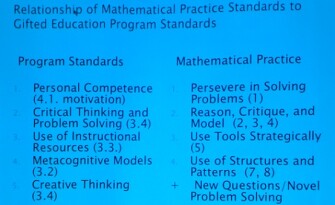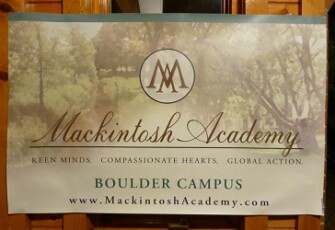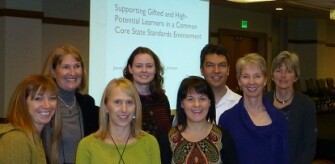I’m excited to be in Denver for the annual National Association for Gifted Children convention. It kicked off today with a full day of longer, in-depth sessions all focused on “Supporting Gifted and High-Potential Learners in a Common Core State Standards Environment.” The morning session was an overview, together with strategies for upgrading and differentiating for gifted students within the CCSS (presented by Susan Johnsen and Joyce Van Tassel-Baska), and the following were some of my “in the moment” thoughts:
* While a lot of us have heard about the CCSS being more challenging and open-ended than the status quo, that doesn’t mean they are actually challenging enough for gifted and advanced learners who will still be beyond the grade-level standard in many areas. As a matter of fact, I worked on reading our Montana CCSS English Language Arts document on the plane ride down yesterday and was disturbed to find statements such as, “Apply grade-level phonics and word analysis skills” and “Read grade-level text with purpose and understanding.” (*groan*)
* The Common Core is not the be-all, end-all. While it may provide a good foundation, it doesn’t cover everything for all kids - and areas that we know to be important to cover for gifted learners (affective needs, for example) are still necessary even if the CCSS doesn’t have many obvious windows for them.
* Questions posed by the presenters: “How do we make curriculum more challenging, more creative, more complex, more in-depth, and accelerated for gifted learners?” “How do we ensure that gifted learners are at the starting line of their instructional level in the classroom?” “What do we do to ensure that gifted students are using their time to progress beyond the grade-level skills they’ve already mastered?” It would seem the questions and challenges for us - the parents and professionals in the field of gifted education - likely won’t be changing radically. (I’m not sure whether that’s good or bad... Both, probably...)
* Pre-assess, streamline, compact, engage, elevate, accelerate, challenge, differentiate. It’s clear that all those strategies we’ve been trying to infuse into classrooms for the benefit of gifted, advanced, and other students are still vitally necessary.
* Strategies for adapting CCSS for gifted learners: 1) Accelerate and streamline, 2) Differentiate and remodel, and 3) Integrate ELA and Math standards. All of the specific examples provided were excellent examples of great things teachers can do & provide for gifted and advanced learners. Perhaps we need to look at the CCSS as a great opportunity to tag these ideas, strategies, and instructional models into our school or district’s implementation of Common Core. We have to be (or remain) a part of the conversation.
* Ideas from the presenters: What can we do? Hold workshops for remodeling curriculum. Design scope and sequence for gifted learners in Math and ELA. Organize professional development on awareness and implementation issues.
* Ideas from the presenters: What can principals do? Support teachers in working to differentiate the CC for gifted students by providing planning time, resources, and commitment to the work. Organize vertical teams to make efficient use of resources and build a scope and sequence. Demonstrate your commitment by ensuring that grouping and flexible teaching are standards in your building.
* Ask yourself: What specific changes can I make in my school or district to promote the CC for gifted students? How can these changes be accomplished? What are barriers and ways to overcome them that I see?
* Resources available from NAGC:
Pre-K-Grade 12 Gifted Programming Standards
FAQ’s about CCSS and Gifted Learners
book: Using the CCSS for Mathematics with Gifted and Advanced Learners
book: Using the CCSS for English Language Arts with Gifted and Advanced Learners
For the next Common Core focused session, I opted for the one aimed at the Math CCSS. Presenters were Linda Sheffield and Susan Johnsen. This slide shows a few pieces of how some of the CCSS match up well with some of the instructional strategies that NAGC’s Programming Standards call for:

Ideas gleaned from Math CCSS session:
* Districts need an expanded menu of challenging options for those students who’ve completed the third (or higher) level math course before (or in some cases long before) their senior year.
* In addition to (or in some cases rather than) acceleration in mathematics for students who excel in that area, also consider what is appropriate pacing for a given student or group of students. A faster pace - or sometimes a slower one to allow for more in-depth examination - may actually be what’s needed.
* Rather than just enrichment opportunities, consider how what is being taught connects to other content areas, other principles and concepts, other skills and standards - and have the students explore these connections.
Lunch was a focused opportunity to connect with colleagues from around the country, commiserate about (and celebrate, too!) our shared experiences as GT coordinators, and learn from one another about new resources and strategies.
In the afternoon, I attended a CCSS session focused on English Language Arts. Presenters were Claire Hughes, Debbie Troxclair, and Joyce Van Tassel-Baska. We were given examples of how a given standard could apply with one activity for ‘typical’ students and with another activity (differentiated, more complex, more in-depth) for gifted and advanced learners. We then brainstormed in groups our own ideas for how to do this for a particular standard and shared them with the whole group. NAGC’s plan is to have multiple such examples available on the NAGC website so teachers can access them to get ideas of ways they can increase depth and complexity for the gifted and advanced learners in their classrooms. I think that’s a great idea. It was inspiring and eye-opening to hear everyone’s ideas - practical, implementable, and definitely appropriately challenging opportunities for the students who are ready for them. It was also an illustration for us of how vertical teaming can demonstrate for our colleagues how any given standard can have its depth and complexity expanded up through the grade levels.
One example is the idea my table partner and I came up with for extending the teaching of capitalization for gifted and advanced students who demonstrate (in pre-assessment) that they have mastered the grade-level or essential goal for that standard. These students could explore historical perspectives of capitalization. How and why have the rules for capitalization changed over time? Why are some words in the Constitution capitalized? How have advances in technology influenced use of and rules about capitalization? What cultural influences impact a society’s use (or lack of use) of capitalization in both formal and informal settings? And on and on...
One key point in this session was that pre-assessment is not about giving the gifted learners something different just because they’re gifted. Pre-assessment is about finding and determining which students (many of whom will happen to be gifted, but not necessarily all) have some level of mastery of the standard and are ready for an in-depth and complex extension.
I am once again this year serving as a mentor for a Javits-Frasier Scholar. The Javits-Frasier scholarships go to about a dozen individuals who work in Title I schools and have never attended an NAGC convention before. The JF Scholar I was matched with is on the Board of Boulder Valley Gifted & Talented, and she invited me to an event they hosted tonight, a “Tribute to the Wisdom of Annemarie Roeper,” who sadly passed away in May at age 93. BVGT took advantage of the opportunity of having so many “luminaries” from the world of gifted education nearby and asked a couple handfuls of them who knew Annemarie well to come and talk about her work and her impact on their lives and the lives of so many others. Together with her Jewish parents and husband, Annemarie escaped Nazi Germany on the last train to leave Austria before the Germans invaded. They found their way to Michigan where Annemarie and her husband George started the Roeper School for gifted students in 1941, now the longest continuously running school for gifted learners in America. Her many books, articles, and poems are reflective journeys into the inner world of the gifted individual. It was such a treat tonight to meet the BVGT Board and the presenters whose insightful words exemplified and honored Annemarie’s life and work. Mostly, it reminded me (and although I hold this philosophy daily, it never hurts to have an outside reminder) of the essence of why I do what I do. It’s about the kids, and helping them come to understand and accept who they are, what their giftedness is and means, how being gifted impacts their lives (and how to manage that), and appreciating and truly seeing each young (and not-so-young) person whose life path crosses mine.
Enjoy these photos from today:
the location for tonight’s tribute to Annemarie


Annemarie’s friends and colleagues sharing memories

with everyone from Montana

the view from my hotel room
